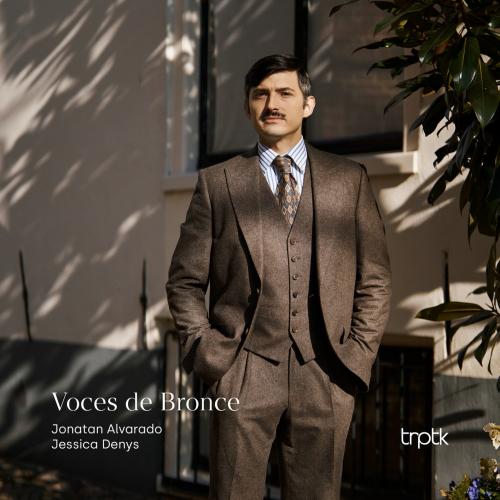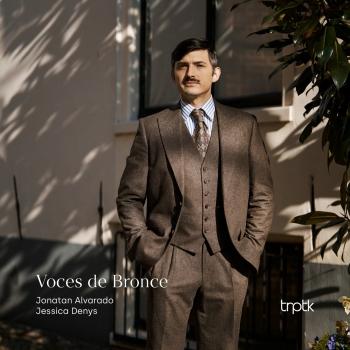
Voces de Bronce Jonatan Alvarado & Jessica Denys
Album Info
Album Veröffentlichung:
2023
HRA-Veröffentlichung:
28.04.2023
Das Album enthält Albumcover Booklet (PDF)
- 1 Amargura ('El Floridense') 03:30
- 2 En vano, en vano...! 02:20
- 3 Estilo criollo, Op.8 No.4 02:06
- 4 Gorjeos ('La Mariposa') 03:51
- 5 Entre colores 02:21
- 6 Canción agreste ('El Milongón') 02:55
- 7 El pañuelo de seda 03:39
- 8 El alma del payador 02:43
- 9 El sueño 03:07
- 10 La vida del carretero 03:11
- 11 La cordobesa 02:22
- 12 Aires criollos No.2: I. La porteñita (Zamba) 01:04
- 13 Aires criollos No.2: II. Recuerdos (Estilo clásico) 02:00
- 14 Vidalita ('Flor Marchita') 04:09
- 15 Claveles mendocinos 03:05
- 16 Chinita linda 02:04
- 17 El Pericón 02:18
- 18 El gato 02:44
- 19 El triunfo 02:28
- 20 Un bailongo (Milonga) 03:20
- 21 Joaquina (Tango) 02:34
- 22 Mi noche triste (Tango-canción) 03:17
Info zu Voces de Bronce
Das erste Mal, dass ich Carlos Gardel hörte, war die Stimme meiner Großmutter mütterlicherseits. Sie sang gerne und nutzte ihre schöne, helle Sopranstimme hauptsächlich, um sich bei der Hausarbeit zu unterhalten. Von ihr lernte ich "Soledad", einen der berühmtesten Tangos von Gardel, den wir zeitlebens "unser Lied" nannten. Meine Großeltern väterlicherseits waren anerkannte Tangotänzer, die regelmäßig an den lokalen und regionalen Milongas und Tanzwettbewerben teilnahmen. Sie hörten jedes Tango-Orchester und jeden Tango-Sänger, der etwas auf sich hielt, von den späten 40er bis zu den 60er Jahren, und später in ihrem Leben wurden sie Mitglieder verschiedener Tango-Vereinigungen, als das Genre an gesellschaftlicher Bedeutung verlor.
Gardel war eine unumgängliche Figur in meinem Leben und die Liebe zum Tango einer der wertvollsten Teile meines Familienerbes. Mit 8 Jahren war ich sogar der jüngste Zuschauer, als die Mercedes-Gardel-Gesellschaft in der örtlichen Bibliothek eine Vorführung von Gardels Film "Mi Buenos Aires Querido" veranstaltete. Meine persönliche Verbindung zu Gardel und seinem Tango war jedoch immer etwas indirekt: eine tiefe, aber ferne Faszination, aber nie eine aktive Auseinandersetzung. Die Themen seiner Texte, der allgemeine Geist der Musik und die Sensibilität, die sie prägt, sind mir immer fremd gewesen. Eine Empfindung, die durch die willkürliche Unterscheidung zwischen dem Kosmopolitismus des Tangos und dem rustikalen Charakter der Folklore, der auch heute noch in Argentinien vorherrscht, nur noch verstärkt wird.
Ich hatte das Gefühl, mich zwischen dem einen oder dem anderen entscheiden zu müssen. Ich entschied mich also für die Musik, die meiner Erfahrung am nächsten kam, die zugegebenermaßen wenig mit amourösen Eroberungen oder den existenziellen Ängsten der tapferen Männer von Buenos Aires zu tun hatte. Schließlich zog ich nach Europa und behielt mein musikalisches Erbe für mich, während ich die Musik des iberischen Mittelalters, der Renaissance und des Frühbarocks der iberoamerikanischen Reiche erforschte. Durch sie entwickelte ich meine eigene musikalische Methode, um historische Quellen zu überzeugenden musikalischen Darbietungen zusammenzuführen.
Meine Interessen verlagerten sich bald von der bloßen Anhäufung von Musikstücken auf die Erforschung der Netzwerke, Institutionen und Gemeinschaften, die ihre Weitergabe und ihr Überleben über die Jahrhunderte hinweg ermöglichten. Vor allem faszinierte mich die Rolle, die subjektive Geschmacksfragen bei der Weitergabe bestimmter Repertoires zwischen verschiedenen Gemeinschaften spielten und dazu führten, dass einige Komponisten zu Legenden wurden und andere in Vergessenheit gerieten. Schon bald begann ich, das historische Repertoire meines Landes mit der gleichen Neugierde zu betrachten, was mich zu Gardels unvermeidlicher Figur zurückbrachte. Ich interessierte mich weniger für seine Tango-Legende als für die tatsächlich lebende historische Figur und die unbestreitbare Rolle, die die Gemeinschaften und das Repertoire des "canto criollo" spielten, die ihn als Künstler definierten.
Jessica Denys, Gesang, Gitarre (Francisco Nuñez, Buenos Aires um 1910)
Jonatan Alvarado, Gitarre (Francisco Rebasti, Buenos Aires 1921)
Juan Vizán, Gesang (Titel 7, 14)
Sophia Patsi, Gesang (Titel 15, 19)
Keine Biografie vorhanden.
Booklet für Voces de Bronce







